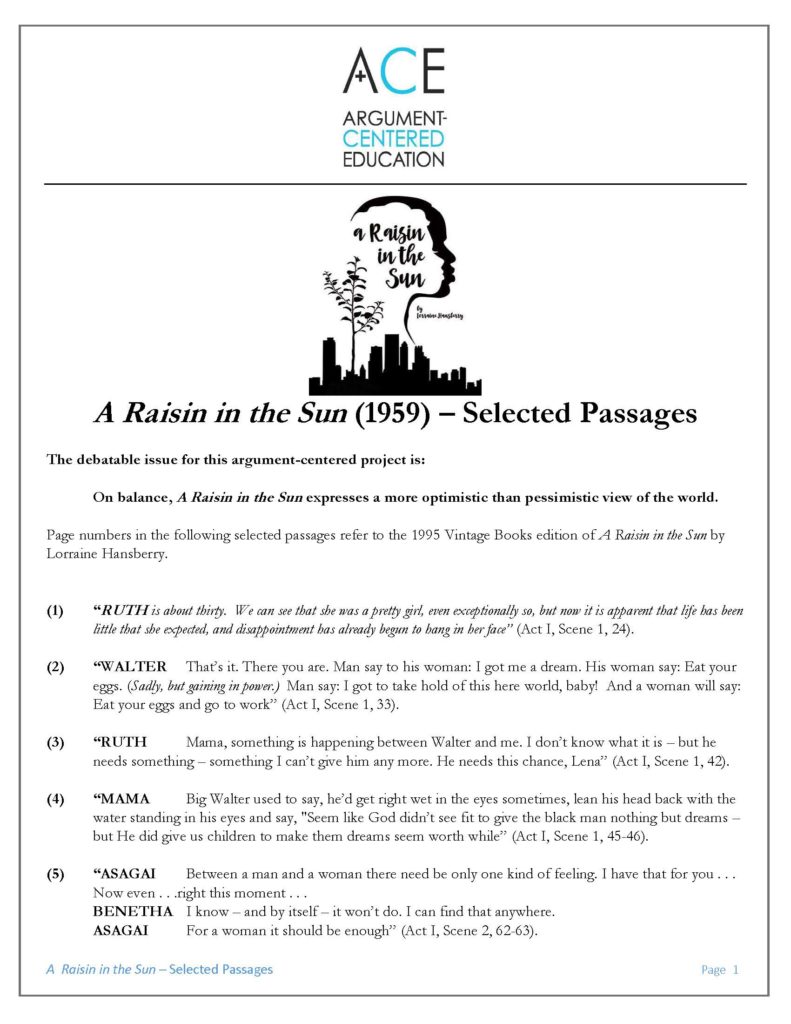
Argumentalizing ‘A Raisin in the Sun’
Lorraine Hansberry’s 1959 play A Raisin in the Sun is a sturdy classic of 20th century American literature and African-American literature and history, and it deserves to be as widely taught in high school English classes as it is. We have worked with multiple partner schools on the work, and our projects have been honed through iterative implementations to focus on several debatable issues, but one in particular.
The three debatable issues that we have helped partner teachers organize their instruction around are these.

The first of these three DI’s directs student attention to characters and characterization in the play, particularly as these are used by Lorraine Hansberry to illustrate and develop the play’s concern with independence and autonomy, and how they reflect on the play’s other thematic concerns — racism, filial bonds and obligations, authentic manhood. The character binaries set up in this debatable issue lend themselves especially well to the Argument Face-Off activity.
The third focuses on the sociological and historical matter in the late 1950s and on into the 1960s of racial assimilation versus racial nationalism or separation. This became a strategic question considered by civil rights movement leaders of this period, and is one that has had residual permutations and lingering effects down through to the present moment.
But it is the second debatable issue that our partner schools have spent the most time with. It is capacious, capturing an extensive range of interpretive meaning-making that we want (typically) 9th or 10th grade students to begin to become comfortable doing, but it also seems sufficiently narrow and focused on a fundamental question Hansberry herself was grappling with, over whether or to what extent America’s racial challenges and the particular condition of American urban common folk were solvable or transcendable.
On balance, A Raisin in the Sun expresses a more optimistic than pessimistic view of the world.
We have developed a set of possible argumentative claims and counter-claims that we use with partner schools in varying ways — to present models, to give students more fully to scaffold their argument and counter-argument building, to prompt refutation activities, to assist their response to counter-arguments in their interpretive essay writing. This basic and widely applicable resource, which we use widely in our argumentalization of units and projects, helps orient instruction and assessments on academic argument. When collaboratively created with partner teachers, it also enables them to have thought through the viable arguments and counter-arguments on both sides of the debatable issue, which is essential to teach effectively using argument pedagogy.

The claims and counter-claims are aligned with the set of selected passages that we have created that can be used by students to harvest textual evidence for their interpretive arguments. Selected Passages should always be balanced between positions; so in this instance there are 10 passages that support the position that the play is more optimistic than pessimistic and 10 passages that support the contrary position. The passages are all aligned with one or more claims on the Possible Claims and Counter-Claims resource. And they can be similarly used with great flexibility — from a more fully scaffolded approach that gives students the Selected Passages to analyze, discuss, and ultimately use in their arguments, to one that doles out a small percentage of them as models and instigators for more autonomous student work.

Finally, we have used informational texts alongside this argumentalized version of interpretive study of the play. I am generally somewhat skeptical of the pairing of informational texts and literary works. Oftentimes the connection between the two is topical, but not thematic or formal in any way. Simply because texts share the same or a similar topic does not mean that their ideas or formal properties are aligned in any way. It’s a little bit like pairing courses in a meal simply because they share a protein or other main ingredient: Chicken Kiev and tacos pollo share a protein but aren’t likely to match well on the plate.
But it can be done effectively, and in this instance I think that pairing A Raisin in the Sun with informational texts on housing discrimination prior to the passage of the 1968 Fair Housing Act couples very well with the environmental backdrop, and even some of the direct thematic concerns, of the play. An extremely thorough and compelling treatment of the historical phenomena of racist urban housing practices is contained in Ta-Nehisi Coates’s famed 2014 Atlantic Magazine essay on reparations. We have excerpted it to significant rounding and enriching effect in the unit on Lorraine Hansberry’s masterwork.


